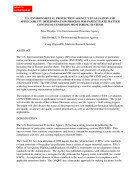Air monitoring
U.S. ENVIRONMENTAL PROTECTION AGENCY’S EVALUATION AND APPLICABILITY DETERMINATION PROCESS FOR PARTICULATE MATTER CONTINUOUS EMISSION MONITORING SYSTEMS
Sep 09 2016
Author: Peter Westlin, Dan Bivins, Craig Clapsaddle on behalf of CEM

Free to read
Articles are free to download. Please login to read this article or create an account.
ABSTRACT
The U.S. Environmental Protection Agency (EPA) has undertaken an evaluation of particulate matter continuous emission monitoring systems (PM CEMS) with a view towards application in future national regulations. This evaluation has begun with a study of the technical background including that in Europe and elsewhere. The EPA has also conducted several field demonstration programs designed to gather information on the feasibility and practicality of applying the technology to different types of industries and PM control approaches. Results of these studies include a new site-specific performance specification for certifying PM CEMS and a new manual PM test method intended to facilitate the calibration testing of these devices at low PM concentration levels. The PM CEMS equipment under investigation include several in-situ light scattering measurement devices and equipment employing extractive sampling with Beta radiation and light scattering measurement technology.
The purpose of this paper is to provide a summary of the scope and content of EPA’s evaluation of PM CEMS relative to application in future stationary source emission regulations. The paper will describe the results of the technical literature survey and the Agency’s field testing projects. The paper will also discuss the status of the proposed new test method, performance specification, and quality assurance and quality control procedures as well as and the potential for regulatory applications.
INTRODUCTION
The U.S. Environmental Protection Agency (EPA) has a strong interest in furthering the development of particulate matter continuous emission monitoring systems PM CEMS. This interest stems from statutory requirements and from a concern for maintaining accurate records of compliance with new and existing regulatory emission limits.
The Clean Air Act Amendments of 1990 require that the Administrator of EPA write standards to limit emissions of hazardous air pollutants from a variety of major industrial sources. EPA’s Office of Air Quality Planning and Standards (OAQPS) is responsible for development of these standards for the Administrator. The Agency has published regulations with emission limits for total particulate matter, as a surrogate for the pollutant the Agency wants controlled (i.e., metal HAPS). An important element of these standards is the need to monitor for compliance with applicable emissions limits. The OAQPS uses a hierarchal approach for making decisions for the best monitoring for these standards. PM CEMS fit within this hierarchy for monitoring a surrogate (particulate matter) for metal or other particulate HAPS. Monitoring data correlated to actual particulate emissions are better than other indirect parametric monitoring as emissions data are better suited to justify compliance determinations or for supporting and defending enforcement actions in court.
Potentially, future regulations may apply PM CEMS to a large number of sources. For example, the OAQPS has published national ambient air quality standards for fine particulate matter (less than 2.5 microns aerodynamic size). These rules will affect how the state and local agencies will regulate industrial particulate and other pollutant sources in order to comply with the ambient standards. These source emissions regulations will likely require measurement and reduction of stack levels of fine particulate matter and other pollutants related to production of ambient fine particulate matter. The PM CEMS technology calibrated to monitor fine particulate at stack conditions used in conjunction with other (e.g., gaseous) CEMS will be an important tool in the source monitoring program resulting from implementation of the ambient air quality standards.
PM CEMS may also serve to replace or augment continuous opacity monitoring systems (COMS) required in other federal or state regulations. This is particularly true where the emission limitations are very low or where COMS are not applicable because of stack conditions. COMS are generally not sensitive enough to PM emissions changes for opacity levels less than ten percent. Correlating opacity data with particulate emission levels is difficult if not impossible for many applications. New regulated emission limits, particularly for metal HAPS, are much lower than in previous regulations. Some PM CEMS may be applicable for wet stacks where COMS are not applicable. Another reason the OAQPS is interested in PM CEMS is the rapid rate of commercial development in the United States. Several instruments are commercially available coincident with the EPA’s field evaluations.
From the industry perspective, PM CEMS are an excellent tool for detecting changes in particulate matter controls and establishing effective maintenance regimens. Other instruments, such as triboelectric monitors have been used quite successfully to trigger fabric filter maintenance prior to compliance problems, but PM CEMS may be more broadly applicable and more sensitive to potential compliance problems especially if a facility is operating near the emissions limitation.
Digital Edition
IET 35.2 March
April 2025
Air Monitoring - Probe Sampling in Hazardous Areas Under Extreme Conditions - New, Game-Changing Sensor for Methane Emissions - Blue Sky Thinking: a 50-year Retrospective on Technological Prog...
View all digital editions
Events
Apr 08 2025 Birmingham, UK
Apr 08 2025 Targi Kielce, Poland
Apr 08 2025 Baku, Azerbaijan
Apr 08 2025 Bahrain
Apr 10 2025 Beijing, China














